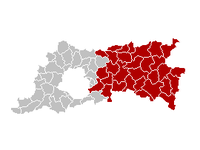| Main | Births etc |
|---|
| ||||||||||||||
| Flemish Brabant Vlaams-Brabant |
|||
|---|---|---|---|
| — Province of Belgium — | |||
|
|||
| Coordinates: Coordinates: | |||
| Country | |||
| Region | |||
| Capital | Leuven | ||
| Government | |||
| • Governor | Lodewijk De Witte | ||
| Area | |||
| • Total | 2,106 km2 (813 sq mi) | ||
| Population (1 January 2012)[1] | |||
| • Total | 1,094,751 | ||
| • Density | 520/km2 (1,300/sq mi) | ||
| Website | vlaamsbrabant.be | ||
Flemish Brabant (Dutch: Vlaams-Brabant [ˌvlaːmzˈbraːbɑnt] ( listen),[2] French: Brabant flamand) is a province of Flanders, one of the three regions of Belgium. It borders on (clockwise from the North) the Belgian provinces of Antwerp, Limburg, Liège, Walloon Brabant, Hainaut and East Flanders. Flemish Brabant also surrounds the Brussels-Capital Region. Its capital is Leuven. It has an area of 2,106 km² which is divided into two administrative districts (arrondissementen in Dutch) containing 65 municipalities.
Flemish Brabant was created in 1995 by the splitting of the former province of Brabant into three parts: two new provinces, Flemish Brabant and Walloon Brabant; and the Brussels-Capital Region, which no longer belongs to any province. The split was made to accommodate the eventual division of Belgium in three regions (Flanders, Wallonia and the Brussels-Capital Region).
It is a province with a rich cultural history and a great diversity of typical products, among them several of the world-famous Belgian beers.
The province is made up of two arrondissements. The Halle-Vilvoorde Arrondissement has Brussels in its middle. It is therefore mainly a residential area, but it also has large industrial zones. For example, it is home to Belgium's main airport. The other arrondissement is the Leuven Arrondissement, centered on Leuven.
The official language in Flemish Brabant is Dutch (as it is in the whole of Flanders), but a few municipalities are to a certain extent allowed to use French to communicate with their citizens; these are called the municipalities with language facilities. Other such special municipalities can be found along the border between Flanders and Wallonia, and between Wallonia and the German-speaking area of Belgium. Halle-Vilvoorde mostly surrounds Brussels, which is officially bilingual but whose inhabitants mostly speak French.
The history of Brabant can be found at the Duchy of Brabant article; see also Duke of Brabant.
Politics[]
The Governor is the representative or "commissioner" of the Federal and the Flemish Government in Flemish Brabant. He is appointed by the Flemish Government, on the unanimous advice of the Federal Council of Ministers. The current Governor is Lodewijk De Witte, he has been the Governor of Flemish Brabant since it was created in 1995 as a result of the splitting up of the Province of Brabant. The Governor is responsible for supervising the local authorities, ensuring that laws and decrees are observed, maintaining public order and security, and coordinating the response to a disaster which has occurred in his province. He also presides over the Deputation, however, he doesn't have the right to vote in the Deputation except in those cases where the Deputation exercises a judicial function.
Flemish Brabant is that only province that has a Deputy Governor as well. The Deputy Governor is appointed by the Flemish Government on the unanimous advice of the Federal Council of Ministers and must have a considerable knowledge of both the Dutch and the French language. He is responsible for ensuring that the language legislation is observed in the peripheral municipalities of Flemish Brabant.
The Provincial Council of Flemish Brabant consists of 72 members elected for a term of office of 6 years (84 members until 2012). The last election was held on Sunday 14 October 2012. Seven political parties have seats in the Provincial Council:
- New Flemish Alliance (N-VA): 19 seats
- Christian Democratic and Flemish (CD&V): 15 seats
- Open Flemish Liberals and Democrats (Open Vld): 13 seats
- Socialist Party – Different (sp.a): 8 seats
- Green (Groen): 7 seats
- Union of Francophones (UF): 5 seats
- Flemish Interest (Vlaams Belang): 5 seats
The current President of the Provincial Council is An Hermans (CD&V). She is assisted by a Bureau which consists of two Vice-Presidents, four Secretaries, three Quaestors and the floor leaders of the fractions in the Provincial Council.
The governing majority in the Provincial Council for 2013-2018 is formed by CD&V, Open VLD, sp.a and Groen. These parties together have a majority of 43 out of 72 seats.
The Deputation is the executive organ responsible for the daily administration of the province. It consists of the Governor and six Deputies elected by the Provincial Council from among its midst. For the 2013-2018 legislative term, the Deputies are divided among the majority parties as follows: two for CD&V, two for Open Vld, one for sp.a and one for Groen.
Municipalities[]
Flemish Brabant has 65 municipalities: 35 in the Arrondissement of Halle-Vilvoorde and 30 in Leuven.

Map showing the location of the Arrondissement of Halle-Vilvoorde

Map showing the location of the Arrondissement of Leuven
| Halle-Vilvoorde arrondissement: | Leuven arrondissement: |
|
References[]
- ^ Population per municipality on 1 January 2012 (XLS; 214 KB)
- ^ Vlaams in isolation: [vlaːms].
External links[]

|
Antwerp | 
| ||
| East Flanders | Limburg | |||
 Flemish Brabant (surrounds Brussels-Capital Region) | ||||
| Hainaut | Walloon Brabant | Liège |
| ||||||||||||||||||||||||




